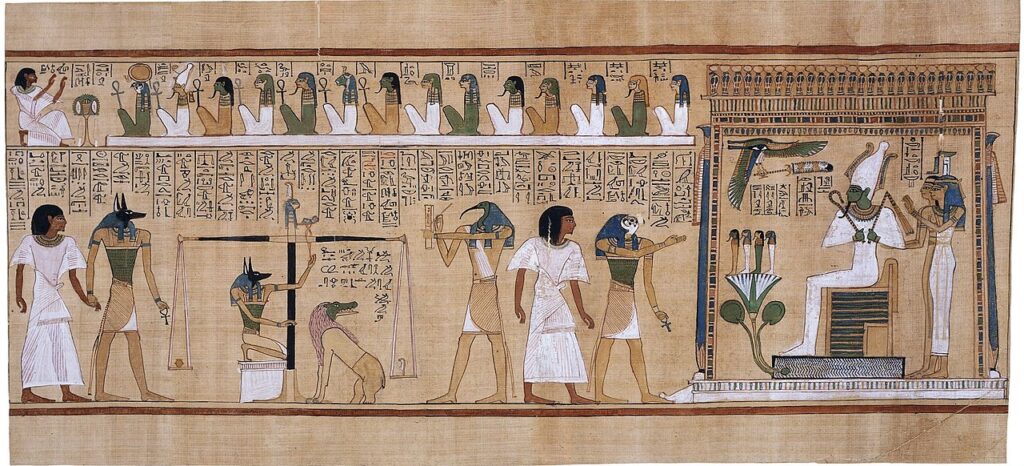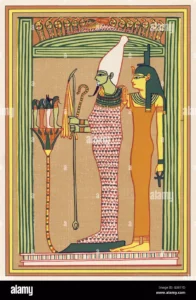Egyptian mythology is an intricate belief system that formed the foundation of one of the world’s oldest civilizations. It encompassed a diverse pantheon of gods and goddesses, each associated with specific aspects of life, nature, and the afterlife. The Egyptians deeply believed in the existence of an afterworld and structured their religious practices around this concept. in this article we will discuss some informations of the god of the afterlife; OSIRIS.
Among the plethora of Egyptian deities, Osiris emerges as a pivotal figure. Revered as the god of the afterlife, resurrection, and fertility. Osiris embodies the profound Egyptian beliefs in the cyclical nature of life and death. His significance extends beyond a divine entity. He represents the ideals of justice, order, and the promise of eternal life after death.
Osiris’s portrayal as a mummified king wearing the atef crown, holding the crook and flail. He signifies his roles as a ruler and a provider of fertility. His story and influence are deeply interwoven into the fabric of ancient Egyptian society

Osiris, born to Nut and Geb, belonged to the Ennead, a group of nine major deities in Egyptian mythology. His siblings included Isis, Nephthys, Set, and Horus, each playing a significant role in Egyptian cosmology. Osiris’s familial ties and divine heritage contributed to his immense power and influence as a deity.
The tales of Osiris recount his rise to kingship. His benevolent rule, and the treacherous murder orchestrated by his jealous brother, Set. The myth highlights Osiris’s dismemberment and scattering of his body parts across Egypt. Isis, displaying unwavering devotion, searched for and reassembled Osiris’s body, leading to his resurrection and ascension as the ruler of the underworld.
Depicted in various forms and artifacts, Osiris’s representation as a mummified pharaoh with the atef crown. holding the crook and flail, holds symbolic significance. The atef crown symbolizes kingship, while the crook and flail embody his authority and ability to bestow fertility. Emphasizing his multifaceted divine nature.
Osiris presided over the Duat. The realm of the dead, where souls embarked on their journey after passing through the trials of the afterlife. As the compassionate ruler of the underworld. Osiris ensured justice, offering the promise of an eternal existence to those deemed worthy. His dominion over the Duat symbolized not only authority but also the continuation of life beyond death.

Central to Osiris’s role was the profound ceremony of the Weighing of the Heart. This symbolic ritual, guided by Anubis and Thoth, involved placing the heart of the deceased on a scale against the feather of Ma’at, the goddess of truth and justice. The balance determined the purity of the soul, ensuring that those who lived in accordance with Ma’at’s principles were granted passage to the afterlife.
Osiris’s worship was deeply intertwined with Egyptian funerary rites and beliefs. The ancient Egyptians believed in an afterlife akin to the earthly realm, replete with fields of paradise and judgment halls. Devotees paid homage to Osiris through rituals involving mummification, tomb decorations, and the placement of amulets to guide the deceased in their journey to the afterworld.
The legend of Osiris revolves around the eternal struggle between Osiris and his treacherous brother, Set. Osiris, as a benevolent ruler, introduced civilization and taught the Egyptians about agriculture and law. Set, consumed by envy and ambition, plotted to overthrow Osiris. In a malevolent act, Set murdered Osiris, dismembered his body, and scattered the pieces across Egypt, seeking to prevent his resurrection.
The commemoration of Osiris’s mythological journey was central to Egyptian festivals, notably the “Feast of Osiris” or the “Osiris Mysteries.” These festivals were deeply rooted in agricultural significance, reflecting the cyclical nature of life, death, and rebirth. They included processions, dramatic reenactments of Osiris’s story, and rituals symbolizing the triumph of life over death and the assurance of resurrection.
The Osiris festivals were not merely celebrations but held profound religious significance. They were occasions to reaffirm faith in the afterlife, offering prayers for the deceased, and seeking blessings for a prosperous life in the hereafter. The festivals were pivotal in fostering a sense of community and reinforcing the fundamental Egyptian beliefs in resurrection and the eternal cycle of life.
Osiris’s resurrection shares striking parallels with other mythological and religious narratives worldwide. Figures like Tammuz in Sumerian mythology, Dionysus in Greek mythology, and Jesus Christ in Christianity also embody the theme of resurrection and eternal life after death. These narratives often serve as symbols of hope, renewal, and the triumph of life over death, resonating across diverse cultures and time periods.
The motif of divine kingship, as embodied by Osiris, is a recurring theme in numerous mythologies. Similar figures, such as the Sumerian ruler Gilgamesh or the Norse god Odin, symbolize not only kingship but also the virtues of wisdom, justice, and order. This archetype reflects the human desire for righteous leadership and the establishment of moral codes within society.
Different cultures adapt and reinterpret similar mythological themes. For instance, Osiris’s role as a god of the afterlife and judge of souls finds echoes in the Hindu deity Yama, who presides over the afterworld and passes judgment on the deceased. Despite cultural variations, the core themes of judgment, the afterlife, and resurrection persist across mythologies, underscoring shared human aspirations and fears.
The enduring resonance of resurrection narratives, including Osiris’s story, continues to influence literature, art, and popular culture globally. Writers, artists, and filmmakers draw inspiration from these timeless tales, infusing them into contemporary narratives that explore themes of life, death, and rebirth.
Osiris’s most prominent relationship was with his sister-wife, Isis. Their union symbolized fertility, royalty, and divine kingship. Isis’s unwavering devotion to Osiris, her role in reassembling his body, and aiding in his resurrection established her as a powerful and revered goddess. Together, Isis and Osiris represent the ideals of love, loyalty, and the promise of eternal life through resurrection.

Osiris’s relationship with his brother Set was marked by jealousy, conflict, and betrayal. Set, driven by envy and ambition, murdered Osiris out of resentment for his rule and popularity among the people. This rivalry between the two brothers symbolized the struggle between order and chaos, a recurring theme in Egyptian mythology.
Osiris fathered Horus with Isis after his resurrection. Horus, the falcon-headed god, became a central figure in Egyptian mythology, embodying kingship, protection, and the triumph of good over evil. The conflict between Horus and Set, seeking vengeance for his father’s death, became a legendary struggle representing the eternal battle between light and darkness.
Thoth, the god of wisdom, and Anubis, the god of embalming and the afterlife, played significant roles in Osiris’s mythological narratives. Thoth assisted in the judgment of souls during the Weighing of the Heart ceremony, ensuring fairness and order. Anubis, often depicted as guiding souls to the afterlife, aided Osiris in the resurrection process, highlighting his importance in funerary rites.
As a member of the Ennead, Osiris had familial ties and interactions with other major Egyptian deities. His relationship with Nut, his mother, and Geb, his father, underscores his divine lineage and connection to cosmic elements, further emphasizing his importance within the Egyptian pantheon.
Osiris stands as a central and revered figure in ancient Egyptian mythology, embodying the ideals of resurrection, justice, and the afterlife. Born to Nut and Geb, Osiris belonged to the Ennead, the nine major deities, and his lineage endowed him with immense power and influence.
His mythological narrative, marked by betrayal, murder, and resurrection, symbolizes the eternal struggle between good and evil, order and chaos. His relationships with Isis, Set, Horus, and other gods played crucial roles in shaping Egyptian beliefs and religious practices.
Osiris’s role as the ruler of the underworld, presiding over the judgment of souls in the Weighing of the Heart ceremony, reinforced the Egyptian belief in a just afterlife. The Osiris festivals, celebrating his resurrection, were integral to Egyptian religious ceremonies, emphasizing the cyclical nature of life and death.
His story of resurrection shares parallels with similar motifs in world mythology, underscoring universal themes of hope, renewal, and the triumph of life over death.
Osiris’s enduring legacy extends beyond ancient Egypt, influencing art, literature, and cultural narratives across civilizations. His symbolism as a god of the afterlife, judge of souls, and symbol of divine kingship continues to captivate the human imagination, reflecting humanity’s timeless quest for immortality and spiritual transcendence.
In essence, Osiris remains an iconic and revered figure, symbolizing the eternal cycle of life, death, and rebirth—a testament to the enduring power of myth and the human aspiration for eternal life.